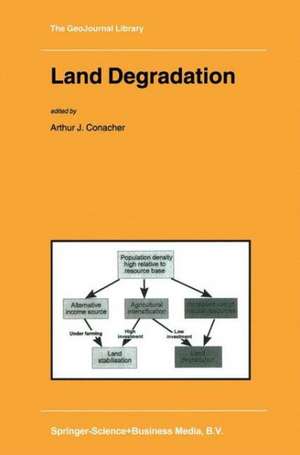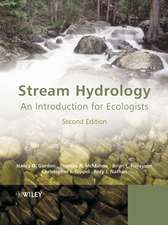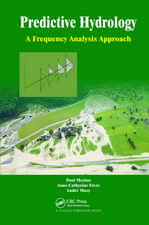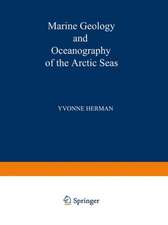Land Degradation: GeoJournal Library, cartea 58
Editat de A.J. Conacheren Limba Engleză Paperback – 6 dec 2010
Audience: The book presents current research findings which will be of particular benefit to professionals and practitioners, as well as researchers and tertiary-level educationalists who are involved with land degradation.
| Toate formatele și edițiile | Preț | Express |
|---|---|---|
| Paperback (1) | 795.36 lei 38-44 zile | |
| SPRINGER NETHERLANDS – 6 dec 2010 | 795.36 lei 38-44 zile | |
| Hardback (1) | 955.70 lei 6-8 săpt. | |
| SPRINGER NETHERLANDS – 28 feb 2001 | 955.70 lei 6-8 săpt. |
Din seria GeoJournal Library
- 15%
 Preț: 642.51 lei
Preț: 642.51 lei - 15%
 Preț: 632.70 lei
Preț: 632.70 lei -
 Preț: 396.78 lei
Preț: 396.78 lei - 18%
 Preț: 948.92 lei
Preț: 948.92 lei -
 Preț: 430.59 lei
Preț: 430.59 lei - 18%
 Preț: 899.69 lei
Preț: 899.69 lei - 15%
 Preț: 581.79 lei
Preț: 581.79 lei - 18%
 Preț: 938.34 lei
Preț: 938.34 lei - 18%
 Preț: 888.80 lei
Preț: 888.80 lei - 15%
 Preț: 703.85 lei
Preț: 703.85 lei - 18%
 Preț: 890.68 lei
Preț: 890.68 lei - 24%
 Preț: 777.63 lei
Preț: 777.63 lei -
 Preț: 400.65 lei
Preț: 400.65 lei - 18%
 Preț: 785.55 lei
Preț: 785.55 lei - 18%
 Preț: 946.55 lei
Preț: 946.55 lei - 15%
 Preț: 661.02 lei
Preț: 661.02 lei - 18%
 Preț: 945.79 lei
Preț: 945.79 lei - 15%
 Preț: 637.28 lei
Preț: 637.28 lei - 15%
 Preț: 637.59 lei
Preț: 637.59 lei - 15%
 Preț: 637.46 lei
Preț: 637.46 lei - 15%
 Preț: 635.31 lei
Preț: 635.31 lei - 20%
 Preț: 568.43 lei
Preț: 568.43 lei - 15%
 Preț: 645.79 lei
Preț: 645.79 lei - 20%
 Preț: 569.85 lei
Preț: 569.85 lei - 15%
 Preț: 651.99 lei
Preț: 651.99 lei - 15%
 Preț: 639.41 lei
Preț: 639.41 lei - 15%
 Preț: 643.48 lei
Preț: 643.48 lei - 15%
 Preț: 663.60 lei
Preț: 663.60 lei - 15%
 Preț: 651.99 lei
Preț: 651.99 lei - 15%
 Preț: 651.02 lei
Preț: 651.02 lei -
 Preț: 390.63 lei
Preț: 390.63 lei -
 Preț: 395.63 lei
Preț: 395.63 lei
Preț: 795.36 lei
Preț vechi: 1046.54 lei
-24% Nou
Puncte Express: 1193
Preț estimativ în valută:
152.21€ • 157.94$ • 127.22£
152.21€ • 157.94$ • 127.22£
Carte tipărită la comandă
Livrare economică 11-17 martie
Preluare comenzi: 021 569.72.76
Specificații
ISBN-13: 9789048156368
ISBN-10: 904815636X
Pagini: 404
Ilustrații: 205 p.
Dimensiuni: 160 x 240 x 24 mm
Ediția:2002
Editura: SPRINGER NETHERLANDS
Colecția Springer
Seria GeoJournal Library
Locul publicării:Dordrecht, Netherlands
ISBN-10: 904815636X
Pagini: 404
Ilustrații: 205 p.
Dimensiuni: 160 x 240 x 24 mm
Ediția:2002
Editura: SPRINGER NETHERLANDS
Colecția Springer
Seria GeoJournal Library
Locul publicării:Dordrecht, Netherlands
Public țintă
ResearchCuprins
Preface. Keynote Paper. 1. Agrodiversity - A Positive Means of Addressing Land Degradation and Sustainable Rural Livelihoods; M. Stocking. Part One: Land Degradation Processes. 2. Geostatistical Analysis and Simulation of West African Sahel Rainfall; A. Chappell, C.T. Agnew. 3. Nebkha Dunes as Indicators of Soil Degradation in the Molopo Basin, South Africa and Botswana; A.J. Dougill, A.D. Thomas. 4. Desertification in an Arid Shrubland in the Southwestern United States: Process Modelling and Validation; G.S. Okin, et al. 5. The Potential for Degradation of Landscape Function and Cultural Values Following the Extinction of Mitika (Bettongia Lesueur) in Central Australia; J.C. Noble, et al. Part Two: Land Degradation as a Response to Land Use Practices and Land Use Change. 6. An Assessment of Soil Erosion in Scotland; D.A. Davidson, et al. 7. Ecological Disturbance and Soil Erosion on Grazing Land in Southwest Iceland; G. Gísladóttir. 8. Land Cover Changes in Sardinia (Italy): the Role of Agricultural Policies in Land Degradation; M. d'Angelo, et al. 9. Environmental Problems Caused by Heavy Application of Nitrogen Fertilisers in Japanese Tea Fields; T. Kato, et al. Part Three: Society and Land Degradation. 10. Soil Sustainability and Land Reform in South Africa; H.K. Watson. 11. Redistribution, Restitution and Reform: Prospects for the Land in the Eastern Cape Province, South Africa; R.C. Fox, K.M. Rowntree. 12. Establishing Farmers' Understanding of Soil Health for the Future Development of`User-Friendly' Soil Monitoring Packages; L.A. Lobry De Bruyn. 13. Understanding Farmer Monitoring of a `Sustainability Indicator': Depth to Saline Groundwater in Western Australia; S.P. Marsh, et al. 14. Needs and Opportunities in Evaluating Land Degradation and Erosion in South-East Asia; I. Douglas. Part Four: Rehabilitation of Degraded Land. 15. Different Techniques of Pasture Improvement and Soil Erosion in a Wooded Rangeland in SW Spain &endash; Methodology and Preliminary Results; S. Schnabel, et al. 16. Land Recovery Following Extensive Sheet Erosion at Menangle, NSW; G.S. Humphreys, B. Groth. 17. Safe Carrying Capacity and Sustainable Grazing: How Much Have We Learnt in Semi-Arid Australia in the Last 170 Years? J. Pickard. 18. Reconsidering the Economic Scope for Rehabilitating Degraded Australian Semi-Arid Rangelands &endash; Issues of Context, Process and Integration; N.D. MacLeod, J.C. Noble. 19. Airborne Geophysics Provides Improved Spatial Information for the Management of Dryland Salinity; R.J. George, D.L. Bennett. 20. Innovative Use of Water Balance Models in Farm and Catchment Planning in Western Australia; G.P. Raper, et al. Part Five: Land Degradation and Policy. 21. Explaining Non-adoption of Practices to Prevent Dryland Salinity in Western Australia: Implications for Policy; D.J. Pannell. 22. Evaluation of Policy Approaches to Dryland Salinity Management in the Kent River Catchment; E.A. Kington, K.R.J. Smettem. 23. Policy Responses to Land Degradation in Australia; J. Conacher, A. Conacher. Closure. 24. Agriculture, Land Degradation and Desertification: Conclu







